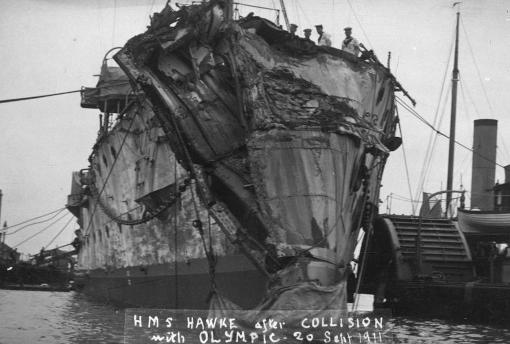It had to happen

Absolutely jack shit going on in my life, day after day, and what do I do? I schedule two Zoom meetings for the same time. Behold, idiot!
That got me thinking about ships that collided in mid-Atlantic, with a whole vasty ocean to navigate. Which is where I found this picture. It is described thusly:
H.M.S. Hawke in collision with R.M.S. Olympic, 1911.
H.M.S. Hawke was an Edgar class cruiser launched in 1891 and on 20th September 1911 was involved in an accident with the recently launched White Star liner R.M.S. Olympic. Olympic was the largest liner in the world at the time displacing 52,067 tons. In the shallow waters of the Solent, it was suggested that during a turn to starboard, the large amount of water displaced forward by the liner had generated a phenomenon of suction behind. With Hawke overhauling Olympic whilst on a parallel course, this suction may have drawn H.M.S. Hawke on to Olympic causing it to ram the hull on the starboard quarter. Here we can see the flattened bow of Hawke with one of the Portsmouth naval paddle tugs alongside.
The Olympic was a sister ship to the Titanic, though Olympic had a long and useful life. Them White Star ladies sure were accident prone, huh?
Happy Monday.
Posted: August 3rd, 2020 under personal.
Comments: 10
Comments
Comment from ExpressoBold
Time: August 3, 2020, 8:51 pm
That must have been some powerful, powerful suckage… unless H.M.S. Hawke was exceeding the marina speed limit.
Comment from Anonymous
Time: August 3, 2020, 9:45 pm
Surprisingly, no-one was seriously injured.
The collision wasn’t exactly mid-Atlantic. The Solent is only 4 miles wide, so it was no more than 2 miles from the shore. Embarrassing for all concerned.
Comment from Anonymous
Time: August 3, 2020, 10:06 pm
ExpressoBold –
The Olympia had 24 double-ended (six furnace) and 5 single-ended (three furnace) Scotch boilers, she was coal burning at the rime of her launch. Two four-cylinder triple-expansion reciprocating engines each producing 25,000 hp for the two outboard wing propellers at 85 revolutions per minute. One low-pressure turbine producing 15,000 hp. Total 65,000 hp produced at maximum revolutions. However, for her time she was fairly economical considering her speed -Olympic consumed 650 tons of coal per 24 hours with an average speed of 21.7 knots on her maiden voyage, compared to 1000 tons of coal per 24 hours for both Lusitania and Mauretania.
So, yeah, that’s some powerful suckage there.
Comment from Rich Rostrom
Time: August 4, 2020, 3:55 am
You scheduled the two Zoom meetings? What two activities are you involved in that involve Zoom meetings, where you are in charge of scheduling?
In general terms; not trying to pry.
Comment from S. Weasel
Time: August 4, 2020, 10:09 am
I know, I know…not an example of two ships meeting mid-Atlantic. I just really liked the picture and the story of major suckage.
One meeting was for my work and one was for Uncle B’s work, Rich. I’m hosting his meeting because I have a paid-for Zoom, hence no time limit.
Comment from durnedyankee
Time: August 4, 2020, 11:18 am
1911?
I understand the Solent is narrow and probably has a lot of traffic, but…
How did they manage to collide without the benefit of modern ultra sophisticated computer navigation aids and systems and highly trained crews?
https://abcnews.go.com/US/uss-mccain-4th-navy-warship-crash-asia-year/story?id=49333429
Comment from Jeff Weimer
Time: August 4, 2020, 2:25 pm
That suction effect is a real thing. During Underway Replenishment (UNREP) Navy ships actually turn outward a few degrees to maintain course. A steering casualty is one of the worst things to happen and force the ships to separate quickly before a crash.
Comment from Deborah HH
Time: August 4, 2020, 3:24 pm
Wait. Wait. I thought Uncle Badger was a wealthy retired gentleman farmer, devoted to growing the finest delicacies for his darling Weasel …
Comment from ExpressoBold
Time: August 4, 2020, 3:46 pm
One more oddity about the Solent and military ship-handling:
In 1545, a naval battle was fought in the Solent between English and French naval forces. The battle was inconclusive with no significant losses other than Henry VIII’s flagship, the Mary Rose, which foundered and sank while making a sharp turn. From a total crew of over 400, fewer than 35 survived the sinking.
from the wikipedia description of “The Solent.”
There are all kinds of variables to consider which existed then but do not exist now, such as number and weight of guns combined with position in the hull of gun ports as well as height and number of masts plus deployment of sails.
I’m surprised no one mentioned my “marina speed” snark nor the obvious observation that H.M.S. Hawke was “tailgating” or at least too close to Olympia when Olympia made a sudden lurch to starboard. Damn lucky Olympia didn’t capsize! H.M.S. Hawke probably saved Olympia.
Comment from BJM
Time: August 8, 2020, 4:29 pm
@Expresso…makes one wonder what White Star’s captain criteria was…they hired two that screwed up rather badly.
One might posit that had the Olympia capsized in the Solent they may have been more cautious with the Titanic in the N.Atlantic.











Write a comment
Beware: more than one link in a comment is apt to earn you a trip to the spam filter, where you will remain -- cold, frightened and alone -- until I remember to clean the trap. But, hey, without Akismet, we'd be up to our asses in...well, ass porn, mostly.<< carry me back to ol' virginny